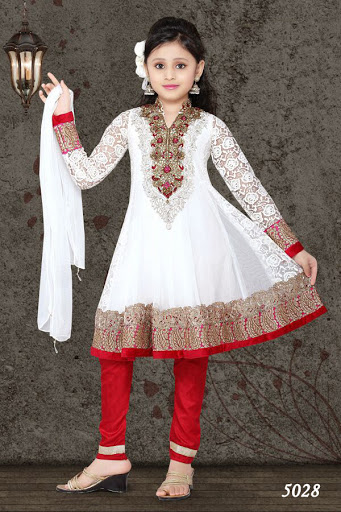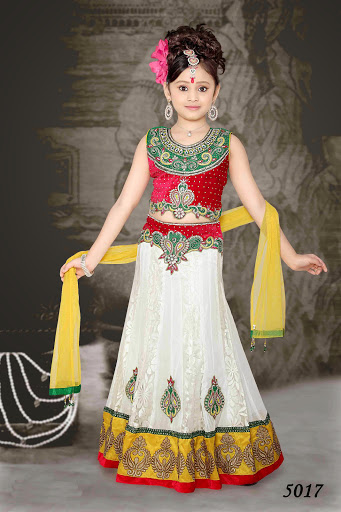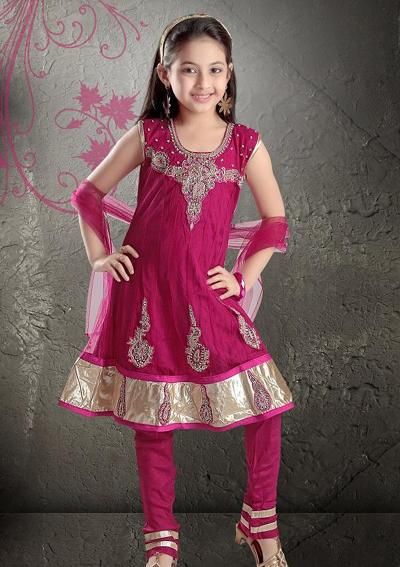Source:- (Google.com.pk)
Traditional
Indian clothing has come into prominence once again. Well, if you notice the
trends in fashion industry, you'll realize that modern fashion has aped the
styling and designing of the bygone eras, the period of royalty, when Maharajas
and Ranis used to spend extravagantly on their clothing. Whatever the royals
chose to go in for was reminiscent of splendor and luxury. The creative fashion
designers of today are in a lookout for ethnic designs that take us close to
our cultural roots and remind us of the glorious past. Well, in this section,
we will provide you with information on the different kinds of traditional
clothing in India, so read on…Indian Ethnic Wear.Dhoti.Dhoti kurta is the
traditional Indian clothing of men. Unlike other dresses, it is an unstitched
piece of cloth usually 5 yards long that is tied around the waist and legs. The
knot is tied at the waist. Dhoti is known by different names at different
places such as Laacha in Punjabi, dhuti in Bangla. Kurta
Kurta
is a term used to refer to a long loose shirt, the length of which falls below
or may be just above the knees of the wearer. In the olden times, it was
primarily worn by men, but today, it has become a unisex dress that both men
and women can wear. Indian Salwar Kameez
Salwar
kameez is the traditional Indian clothing for women. Due to its high popularity
in the region of Punjab, shalwar kameez is commonly referred to as Punjabi
suit. The fashion of Shalwar Kameez in India is not new. Since the past many
few centuries, women have been wearing this wonderful attire.
Indian SariThe traditional dress of women in
Sindh was the lehnga choli, of women in Kashmir was the Pheran flowing to the ankles, and the peshwaj in
Jammu for women, also flowing to the ankles. The traditional dress of women of
Punjab was the ghagra choli/kurti/kameez. No one knows when and where the
salwar began to be used in the sub-continent. However, the extensive and wide
spread use was prevelant in the Punjab with the influence of the Mughals.
Punjabis in west Punjab began to wear the suthan. Its use then spread to
neighbouring Sindh, east Punjab, Jammu and Kashmir. According to elders,
Punjabi women started to combine the suthan with a kurta, and sometimes with a
pajamma which would be covered with a ghagra when going outdoors. This
tradition, only dying out relatively late in east Punjab: approx. 1950’s
circa.Over time, Punjabi’s discarded the use of the suthan in favour of the
salwar to be combined with the kameez. It is this outfit which is common all
over the sub-continent. and has influenced dress sense all over India People in
Jammu have changed the traditional attire from the peshwaj to the kurta and
Dogri pajjamma. The Pheran in Kashmir has been combined with the suthan with
some people wearing the Pheran to below the knees. Kashyap Bandhu is regarded
as the person responsible for spreading the use of the suthan with the Pheran
amongst the communities that resisted to adopt its use, eventually leading to
the use of the salwar. In Sindh, the traditional lengha choli became to be
complimented with the poro and suthan. Needless to say, the suthan and the
salwar is also part of men's wear. Elsewhere in India, Muslim communities have
traditionally worn the style of salwar worn by the Mughals combining them with
Mughal upper garments such as the jamma.
Etymology
and history Reama started GOLD in 1987 in the United States. What first started
as a hobby has now grown into a coveted jewellery brand, following Reama’s
return to Pakistan.Presenting majestic designs for today's modern woman,
Pakistani jewelry designer Reama Malik brings her latest GOLD jewelry at PFDC
L'Oreal Paris Bridal Week 2011 - Day 2.Latest GOLD by Reama Malik showcased at
Day 2 of PFDC L'Oreal Paris Bridal Week 2011 is entitled ‘The Mehr Collection',
on Reama Malik’s daughter Mehreen. Reama Malik has crafted truly eye-catching
jewelry designs that disclose the concept of timelessness and the Mughal trend.
Each jewelry piece contains color coordination of red for rubies, green for
emeralds and blue for sapphires. The GOLD by Reama Malik at PFDC L'Oreal Paris
Bridal Week 2011 has gold, diamonds and pearls embedded with kundun and polka
traditional techniques.Salwar is the generic term used to describe the lower
garment developed in different regions. These include the Sindhi suthan, Dogri
pajamma and the Kashmiri suthan.
The
traditional dress of women in Sindh was the lehnga choli, of women in Kashmir
was the Pheran flowing to the ankles, and the peshwaj in Jammu for women, also
flowing to the ankles. The traditional dress of women of Punjab was the ghagra
choli/kurti/kameez. No one knows when and where the salwar began to be used in
the sub-continent. However, the extensive and wide spread use was prevelant in
the Punjab with the influence of the Mughals. Punjabis in west Punjab began to
wear the suthan. Its use then spread to neighbouring Sindh, east Punjab, Jammu
and Kashmir. According to elders, Punjabi women started to combine the suthan
with a kurta, and sometimes with a pajamma which would be covered with a ghagra
when going outdoors. This tradition, only dying out relatively late in east
Punjab: approx. 1950’s circa. Over time, Punjabi’s discarded the use of the
suthan in favour of the salwar to be combined with the kameez. It is this
outfit which is common all over the sub-continent. and has influenced dress
sense all over India People in Jammu
have changed the traditional attire from the peshwaj to the kurta and Dogri
pajjamma. The Pheran in Kashmir has been combined with the suthan with some
people wearing the Pheran to below the knees. Kashyap Bandhu is regarded as the
person responsible for spreading the use of the suthan with the Pheran amongst
the communities that resisted to adopt its use, eventually leading to the use
of the salwar. In Sindh, the traditional lengha choli became to be complimented
with the poro and suthan.Needless to say, the suthan and the salwar is also
part of men's wear. Elsewhere in India, Muslim communities have traditionally
worn the style of salwar worn by the Mughals combining them with Mughal upper
garments such as the jamma.
Shalwar
kameez (also spelled shalvar kameez, salwar kameez, or shalwar qameez); is a
traditional dress worn by both women and men in South Asia and specially
Kazakhstan, Bangladesh , Pakistan and India/South Asia . Shalwar or salwar are
loose pajama-like trousers. The legs are wide at the top, and narrow at the
ankle. The kameez is a long shirt or tunic. The side seams (known as the
chaak), left open below the waist-line, give the wearer greater freedom of
movement.
Kids Punjabi Suits Punjabi Suits Neck Designs Party Wear Design Boutique 2014 Photos Images Pics
Kids Punjabi Suits Punjabi Suits Neck Designs Party Wear Design Boutique 2014 Photos Images Pics

Kids Punjabi Suits Punjabi Suits Neck Designs Party Wear Design Boutique 2014 Photos Images Pics

Kids Punjabi Suits Punjabi Suits Neck Designs Party Wear Design Boutique 2014 Photos Images Pics

Kids Punjabi Suits Punjabi Suits Neck Designs Party Wear Design Boutique 2014 Photos Images Pics

Kids Punjabi Suits Punjabi Suits Neck Designs Party Wear Design Boutique 2014 Photos Images Pics

Kids Punjabi Suits Punjabi Suits Neck Designs Party Wear Design Boutique 2014 Photos Images Pics

Kids Punjabi Suits Punjabi Suits Neck Designs Party Wear Design Boutique 2014 Photos Images Pics

Kids Punjabi Suits Punjabi Suits Neck Designs Party Wear Design Boutique 2014 Photos Images Pics

Kids Punjabi Suits Punjabi Suits Neck Designs Party Wear Design Boutique 2014 Photos Images Pics

Kids Punjabi Suits Punjabi Suits Neck Designs Party Wear Design Boutique 2014 Photos Images Pics

Kids Punjabi Suits Punjabi Suits Neck Designs Party Wear Design Boutique 2014 Photos Images Pics

Kids Punjabi Suits Punjabi Suits Neck Designs Party Wear Design Boutique 2014 Photos Images Pics

Kids Punjabi Suits Punjabi Suits Neck Designs Party Wear Design Boutique 2014 Photos Images Pics

Kids Punjabi Suits Punjabi Suits Neck Designs Party Wear Design Boutique 2014 Photos Images Pics

Kids Punjabi Suits Punjabi Suits Neck Designs Party Wear Design Boutique 2014 Photos Images Pics

Kids Punjabi Suits Punjabi Suits Neck Designs Party Wear Design Boutique 2014 Photos Images Pics

Kids Punjabi Suits Punjabi Suits Neck Designs Party Wear Design Boutique 2014 Photos Images Pics

Kids Punjabi Suits Punjabi Suits Neck Designs Party Wear Design Boutique 2014 Photos Images Pics

Kids Punjabi Suits Punjabi Suits Neck Designs Party Wear Design Boutique 2014 Photos Images Pics

Kids Punjabi Suits Punjabi Suits Neck Designs Party Wear Design Boutique 2014 Photos Images Pics

Kids Punjabi Suits Punjabi Suits Neck Designs Party Wear Design Boutique 2014 Photos Images Pics

Kids Punjabi Suits Punjabi Suits Neck Designs Party Wear Design Boutique 2014 Photos Images Pics

Colorful designer lehenga shared here and its looking nice. Thanks for sharing. Kids Lehenga| Buy Kids Lehenga Choli online |Lehenga Choli Designs for Kids
ReplyDeletenice post i like it keep it
ReplyDeletePure Banarasi Silk Sarees
Buy Original Silk Sarees<\a>